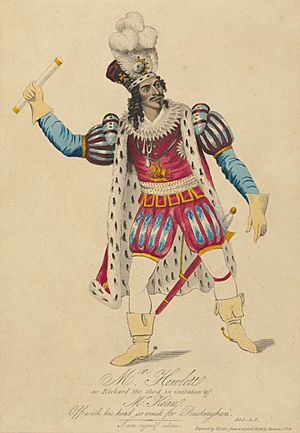African Grove facts for kids
The African Grove Theatre opened in New York City in 1821. It was started and run by William Alexander Brown, a free black man from the West Indies. This was six years before slavery officially ended in New York state in 1827. The theatre welcomed all kinds of black New Yorkers, including free people, enslaved people, and people from different social classes. Some white people also attended. It was the first place where Ira Aldridge, who later became a very famous Shakespearian actor, saw a play by Shakespeare.
Contents
About the African Grove Theatre
For several years, the African Company—the group that performed at the African Grove—put on classic plays and many others. All the actors and crew were black. Most of the audience members were also black. This theatre was the most successful of a few attempts to create a black theatre in New York City. At one point, the theatre even had to build extra seats for white audiences who wanted to watch the shows.
After a few years, city officials closed the African Grove. They said it was because of noisy behavior from the audience. However, this kind of behavior was common among working-class white theatre audiences at the time. Many people believe the real reason was that this black theatre was becoming very popular and successful. Some sources say the theatre "mysteriously burned to the ground in 1826." Other records show no information about the theatre after 1823.
Who Started It?
The theatre was founded by William Alexander Brown. He was a talented actor and playwright from the West Indies. He had worked as a ship's steward, which allowed him to travel to England and the Caribbean. Because of his travels, he saw more theatre than most people in New York at that time.
Brown left his job on a ship and bought a house in New York. He started by holding performances in his backyard. He offered food and drinks, along with poetry and short plays. A regular customer and entertainer named James Hewlett suggested they hire more black actors. Together, they built the African Company.
What Plays Did They Perform?
The theatre often performed plays by Shakespeare. They also included funny short acts called entr'actes between the main parts of the plays. White audience members had to sit in a separate section. The theatre management explained that "whites do not know how to conduct themselves at entertainments for ladies and gentlemen of color." The most popular plays were Richard III and Othello. James Hewlett was the first black actor known to play the main role in Othello.
Like many theatres at the time, the African Company changed Shakespeare's plays to fit their needs. They had small casts and small budgets. For example, in an 1821 show of Richard III, one actor played both King Henry and the Duchess. Another actor played Lady Anne and Catesby. Lady Anne even sang a song that didn't fit the play! The actor playing Richard III was described as a "dapper, wooly haired waiter." This actor was James Hewlett.
Challenges and New Plays
The theatre faced many challenges. The police often bothered them, and white people became more unfriendly. Because of this, the company moved several times. They moved from Thomas Street to Bleecker and Mercer Streets. These streets were at the edge of New York City's developed areas at the time.
When Brown moved his theatre, he realized it was now too far from his main audience of "free persons of color." So, he built a new theatre building close to a popular white theatre called the Park Theatre.
The Park Theatre was New York City's main theatre. When it put on Richard III with a famous English actor named Junius Brutus Booth, the African Company rented a hall right next door. They performed their own version of Richard III on the same night. This was a big competition! Stephen Price, who owned the Park Theatre, even caused a disturbance. He paid people to cause trouble so the police would close down the African Grove.
Besides Shakespeare, the African Company also performed new plays. One of these was William A. Brown's play, The Drama of King Shotaway. This play is now lost, but it told the story of Garifuna leader Joseph Chatoyer. He was involved in the Second Carib War on the island of Saint Vincent. The Drama of King Shotaway was performed in 1823. It is believed to be the first full-length play by a black American performed in the United States.
Even though it moved often and only performed for a short time, the African Grove Theatre was very important. It was a key place for talented African-American actors like James Hewlett to perform.
See also


